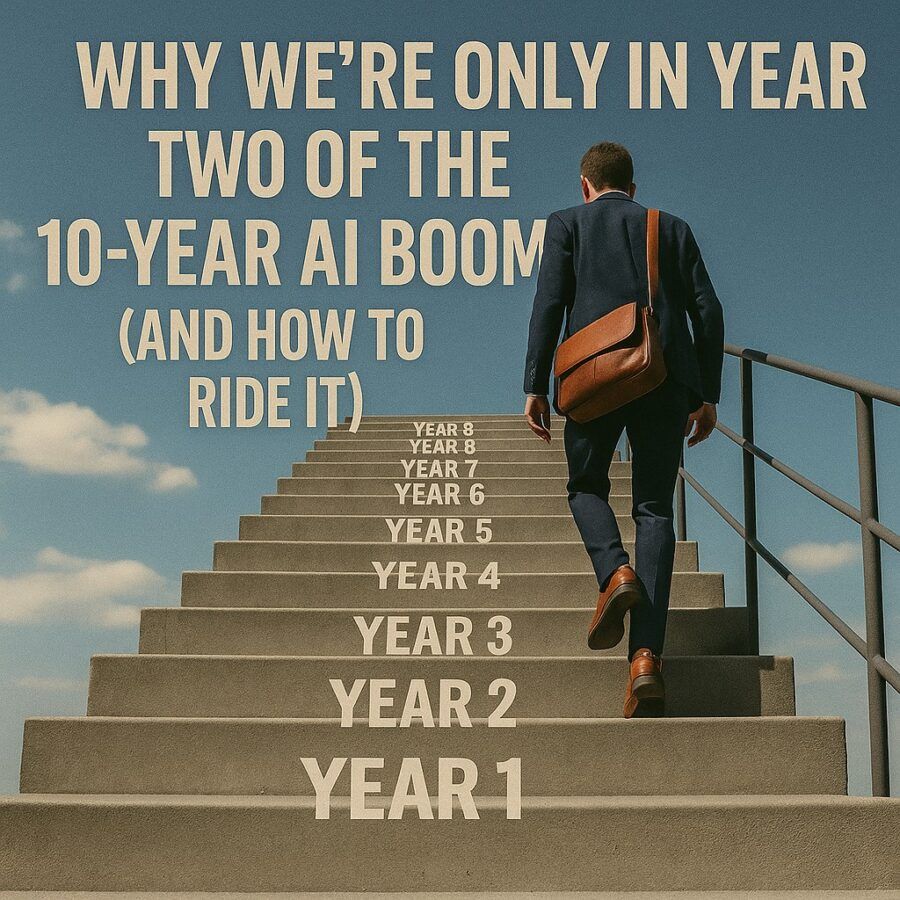Views: 5
Economic history teaches us that technology revolutions unfold in waves. The dot-com surge of the late 1990s transformed communications. The smartphone era beginning in 2007 reshaped global culture. Today, artificial intelligence is on a similar trajectory. Analysts, founders, and investors increasingly agree: we are standing at the start of a decade-long acceleration of AI. The truth is that we are not at the end of the story. We are only in year two of the 10-Year AI Boom.
This article examines why the boom has only just begun, where the momentum is building, and how people and organizations can position themselves to benefit. The lessons are drawn from historical patterns, market data, and early adoption stories that signal a long runway ahead.
The Early Stage of a Long Cycle
Every major technological cycle starts with initial breakthroughs followed by mass adoption. In the AI case, breakthroughs came with large language models, computer vision improvements, and open-source frameworks. The past two years delivered public-facing tools like ChatGPT, Midjourney, Claude, and Gemini. These captured attention, but they are early signals rather than peak moments.
The 10-Year AI Boom is only in its second year because most industries have not yet integrated AI deeply. What we see now is comparable to smartphones in 2008, when early adopters experimented but the real business transformations were still ahead. The infrastructure is being laid, but the long-term benefits remain untapped.

Why Year Two Matters
Why call this moment “year two”? The first year of the boom was defined by novelty. Tools surprised the public. Students wrote essays with AI. Designers created surreal images. Businesses experimented. Now, in year two, experimentation is giving way to structured integration. Enterprises are building agentic workflows, universities are embedding AI literacy into curricula, and startups are scaling beyond demos into serious platforms.
This stage matters because it separates hype from lasting value. Year two of the 10-Year AI Boom is about infrastructure, governance, and sustained use. Just as the early internet required protocols and standards, AI requires frameworks that make adoption reliable.
The Capital Inflow Behind the Surge
Another reason we are early in the cycle is capital. Venture funding for AI in 2023 and 2024 exceeded $50 billion worldwide. Yet the largest institutional investors are still allocating modest percentages compared to what they directed toward cloud computing a decade ago. That means there is significant capital still on the sidelines.
As regulatory clarity improves and real-world case studies multiply, more capital will flow. Historically, investment booms accelerate once early proofs of concept turn into necessity. The 10-Year AI Boom will likely follow this arc, making current years the entry point rather than the peak.
Industries Still Waiting to Transform
One way to measure where we are in the cycle is by identifying industries that have only touched the surface.
- Healthcare: Early experiments with AI diagnosis exist, but systemic integration across hospitals is rare. The transformation of patient care is still ahead.
- Education: A few schools have AI tutors, yet national curricula remain unchanged. The boom will grow as governments standardize AI-powered learning.
- Manufacturing: Predictive maintenance and robotics are appearing, but most factories remain largely analog. The adoption curve is steep but young.
- Finance: Algorithms have traded stocks for years, yet customer-facing agents for banking and insurance remain in infancy.
Each industry is poised for disruption, reinforcing that the 10-Year AI Boom is still near its starting point.
The Rise of AI Agents
Year two also introduces a shift from passive tools to active agents. Tools generate text or images. Agents plan, remember, and act autonomously. Early frameworks show agents booking meetings, writing code, and managing workflows.
In the coming years, these agents will integrate into daily business processes, replacing repetitive tasks across sectors. If the first stage of the boom was about surprise outputs, the next stage is about delegation. This is why we are still so early. The leap from tool to agent is only beginning, and it will drive much of the 10-Year AI Boom.
Infrastructure and Hardware Are Scaling
The hardware that fuels AI is still scaling. Graphics processing units remain in high demand. Data centers are racing to expand capacity. Nations are competing for chip sovereignty. All of this points to an infrastructure phase comparable to the early days of electricity grids.
Until the compute bottleneck eases, many applications cannot reach full scale. Once hardware expansion stabilizes, mass adoption will accelerate. We are only in year two of that process, underscoring that the runway for the 10-Year AI Boom is long.
Lessons from the Internet and Smartphones
The dot-com boom and the smartphone boom teach us that transformative technology requires years to mature. The internet of 1995 looked primitive compared to 2005. Smartphones in 2008 looked limited compared to 2018.
AI today resembles those early years. Tools are powerful but clunky. Interfaces are often confusing. Regulations remain unsettled. Ten years from now, today’s systems will look like prototypes. This historical lens confirms why we are in the early days of the 10-Year AI Boom.
How to Ride the Wave as a Professional
Individuals can benefit by developing literacy in AI workflows. For professionals, this means:
- Learning prompt engineering. Understanding how to extract useful results gives a career advantage.
- Experimenting with agents. Hands-on practice with task delegation prepares you for future workplaces.
- Combining human judgment with AI output. The winners will not be those who know AI exists but those who integrate it seamlessly into daily work.
Being early in the 10-Year AI Boom means there is still time to build skill sets that will dominate in the coming decade.
How Small Businesses Can Gain
Small businesses often lag behind large corporations in adopting new technology. Yet in the case of AI, the barrier to entry is low. Affordable models, plug-and-play tools, and cloud-based services mean small shops can automate tasks once reserved for large enterprises.
Examples include customer support chatbots, inventory forecasting, marketing content generation, and bookkeeping agents. Riding the 10-Year AI Boom for small businesses is about speed. Early adopters will gain cost advantages and customer loyalty before late adopters catch up.

The Investor’s Perspective
For investors, the second year of the boom is about positioning. Early venture bets focus on infrastructure and model development. Public market investors look for companies integrating AI to increase margins.
The lesson from past booms is that not every company survives, but the underlying trend endures. Internet stocks crashed in 2000, yet the internet became the backbone of global commerce. Investors who ride the 10-Year AI Boom strategically will see volatility but also long-term growth.
Risks Along the Way
Every boom carries risk. In AI, risks include data privacy, bias, job displacement, and regulatory overreach. There is also the danger of bubbles, where valuations outrun practical adoption.
Acknowledging these risks does not undermine the case for a decade-long boom. Instead, it emphasizes the need for careful navigation. The 10-Year AI Boom will reward those who balance optimism with prudence.
The Global Race for AI Leadership
Another signal of an extended cycle is geopolitics. Nations are racing to claim leadership in AI. The United States, China, and the European Union are investing heavily in research, hardware, and regulation. Emerging markets are also entering the race with unique applications.
Such global competition ensures sustained focus for years to come. Unlike short-lived trends, AI is a national priority. That reality guarantees that the 10-Year AI Boom is not a flash in the pan but a structural transformation.
Cultural Shifts Ahead
Technology does not just change economics. It reshapes culture. The printing press altered religion. The internet altered relationships. AI is beginning to alter identity and creativity.
Artists debate the authenticity of AI-generated works. Students question what learning means when answers can be generated instantly. Workers ask what it means to build a career alongside autonomous systems. These cultural debates are in their infancy. As they evolve, they will reinforce that we are early in the 10-Year AI Boom.
The Path to Year Ten
So what might year ten look like? By then, AI agents may handle most repetitive tasks in knowledge work. Healthcare systems may deliver personalized medicine. Education may rely on adaptive tutors. Factories may run with predictive optimization.
In year ten, AI will be less visible because it will be everywhere. Just as the internet became background infrastructure, AI will fade into daily life. Recognizing that vision helps explain why today feels like year two of a much longer cycle.
Practical Steps to Ride the Boom
For those seeking concrete actions, consider:
- Learn continuously. Follow new releases, case studies, and frameworks.
- Invest in adaptability. Tools will evolve; mindset matters more than specific platforms.
- Balance automation with authenticity. Use AI to handle tasks, but keep your human touch.
- Network with adopters. Communities experimenting early often share insights that pay dividends later.
Riding the 10-Year AI Boom requires participation, not passive observation.
Why Patience Will Be Rewarded
Finally, patience is critical. Many expect immediate transformation. But revolutions unfold gradually. The first cars looked unimpressive. The first smartphones lacked today’s sophistication. AI will follow a similar curve.
Those who stay patient and keep building will benefit most. The 10-Year AI Boom is not about instant wins. It is about sustained participation in a decade-long revolution.
Closing Perspective
The evidence is clear. Breakthroughs, capital, industry adoption, and cultural shifts all point to the beginning of a long cycle. We are not at the end of the story. We are at the start.
Recognizing that we are only in year two of the 10-Year AI Boom is both humbling and empowering. Humbling because the journey is larger than any one company or individual. Empowering because there is time for anyone—student, entrepreneur, investor, or retiree—to step onto the wave.
The boom belongs not only to engineers in labs but to everyone willing to learn, adapt, and create alongside intelligent machines. Ten years from now, people will look back at this stage and realize these were the formative days. The smart choice is to ride the wave now, while it is still gathering strength.


](https://altpenguin.com/wp-content/uploads/2025/08/veed-ad.webp)

